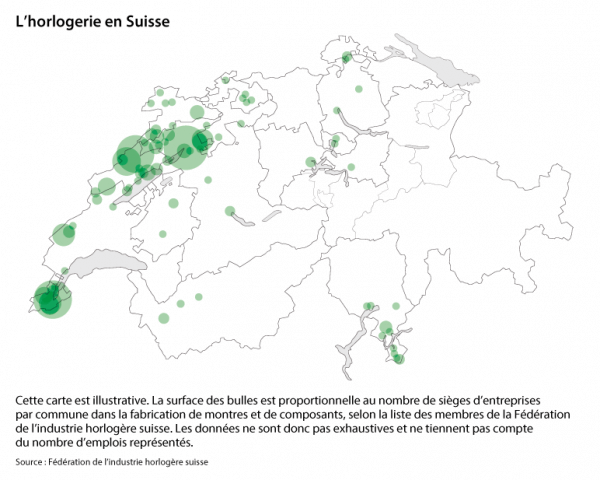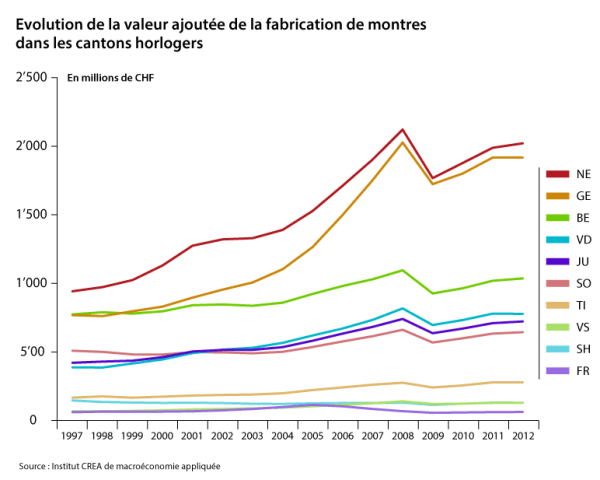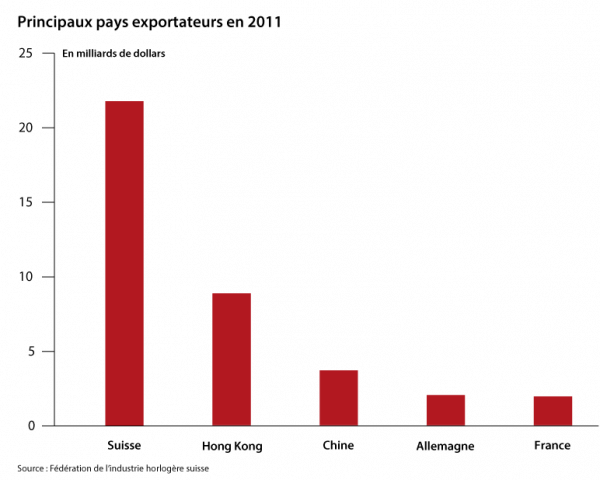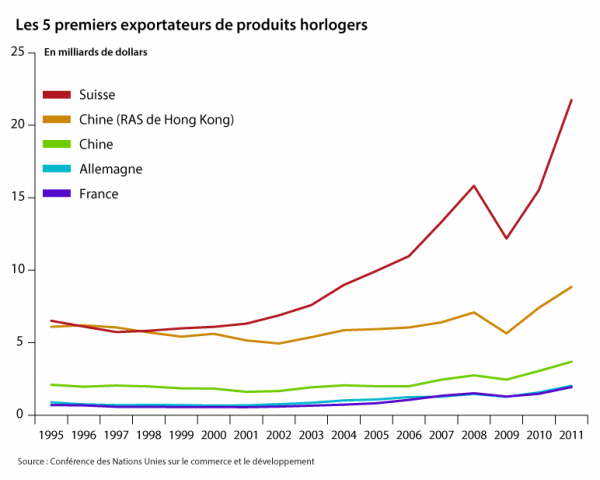De l’or dans la montagne! – There’s gold in them thar hills! The title which the Banque Cantonale Vaudoise (BCV) gave to its meticulous survey of the Swiss watch industry, presented to the press mid-April, sets the tone. In its 63-page report, the bank examines the reasons behind the industry’s success, looks back over the painful quartz crisis of the 1970s and 80s, and describes how the major watch groups formed. The survey also turns the spotlight on the internationalisation that has swept the branch these past years, as well as the rise of the small, independent brands. The author of the study, Jean-Pascal Baechler, an economic advisor at BCV, draws ten conclusions from his investigation.
- Watchmaking goes fast. Very fast, even. The sector is posting growth well in excess of the Swiss economy as a whole. It gained 4.5% a year between 1997 and 2012 compared with “just” 2% for Switzerland’s GDP, based on estimates by Crea, the macroeconomic research institute at University of Lausanne.
- Despite its high profile, watchmaking is, relatively speaking, an economic lightweight. It produces 1.5% of the country’s added value and 1.3% of jobs. “Watchmaking nonetheless plays a fundamental role in conveying Switzerland’s image around the world”, says the report.
- Switzerland is the biggest contributor in value terms and accounts for virtually half the watches sold worldwide (45%). Even so, Swiss watchmakers produce just 2% of exported watches, with China and Hong Kong accounting for 90% of global sales in volume. “Switzerland is at the top of the high-end segment with an export value of US$ 688 per watch compared with US$ 15 for Hong Kong and US$ 2 for China,” the survey concludes.
- That Swiss watches are increasingly expensive won’t come as a surprise. BCV has calculated the rampant inflation within the sector. At current value, the average export price jumped from CHF 149 in 1988 to CHF 693 in 2012. “This represents an average increase of 6.6% a year across every segment, quartz and mechanical, with or without precious metals.”
- French-speaking Switzerland plays a dominant role. Of the six main watchmaking cantons, four are French-speaking (Geneva, Jura, Neuchâtel and Vaud) and two German-speaking (Berne and Soleure). The four French-speaking cantons account for almost 70% of added value for the sector nationwide. Watchmaking is also part of the economic fabric in Tessin, Valais, Schaffhausen and Fribourg, but they account for just 6% of the branch.
- One canton in particular, Vaud, stands out. Watchmaking has spread throughout the legendary Vallée de Joux, which has developed into a hub of complicated watchmaking. The BCV lists Audemars Piguet, Blancpain, Breguet, Bulgari, Jaeger-LeCoultre, Patek Philippe and Vacheron Constantin as being established there, alongside less well-known but no less prestigious names such as Pierre DeRoche, Philippe Dufour, Romain Gauthier and Claude Meylan. Vallée de Joux is also home to numerous suppliers, including a production site belonging to ETA, an important movement manufacturer.
- The branch has clearly recovered from the 1970-1980 crisis. The number of people it employs has risen from less than 30,000 in 1987 to more than 50,000 today, although this is still considerably less than the 90,000 people who worked in the branch in 1970. In contrast, exports are now higher. Over the four decades, they have grown eightfold to reach CHF 21.4 billion in 2012.
- Swiss watchmaking has focused on its brands and the emotional appeal of its products to seduce customers around the world. A Swiss watch is more than just a timepiece; tradition, innovation, precision, design and dreams are all concentrated in its small space. Once a serious rival, Japanese watchmaking chose to focus on technology instead, and has continued to lose ground to other Asian competitors.
- “Swiss-Made is a powerful selling point.” The Swiss Confederation has proposed legislation that would reinforce the criteria that define Swiss-Made. Watchmaking, just one of the segments concerned by the project, has campaigned for even tighter rules.
- Part of the watch industry is still dependent on Swatch Group for supplies of movements and parts, a longstanding situation which the Group wants to bring to an end. One of the most important challenges for the branch is for companies which haven’t already done so to develop sufficient production capacity to function independently of the world’s number-one watch group
Evidently, the observations that emerge from the report are far from revolutionary, but they do provide a global picture of the branch and its past. They also shed light on the challenges that face the industry today. The report, in addition, examines the spectacular growth of Asia as a market for Swiss watches. In 2012, at CHF 11.6 billion, exports to Asia alone equalled total exports in 2004. In 25 years, sales to the region have increased almost sixfold. Yet as Jean-Pascal Baechler notes, worldwide growth in exports has been no less spectacular. In a quarter of a century, they have more than quadrupled, rising from CHF 5.1 billion in 1988 to CHF 21.4 billion in 2012.















